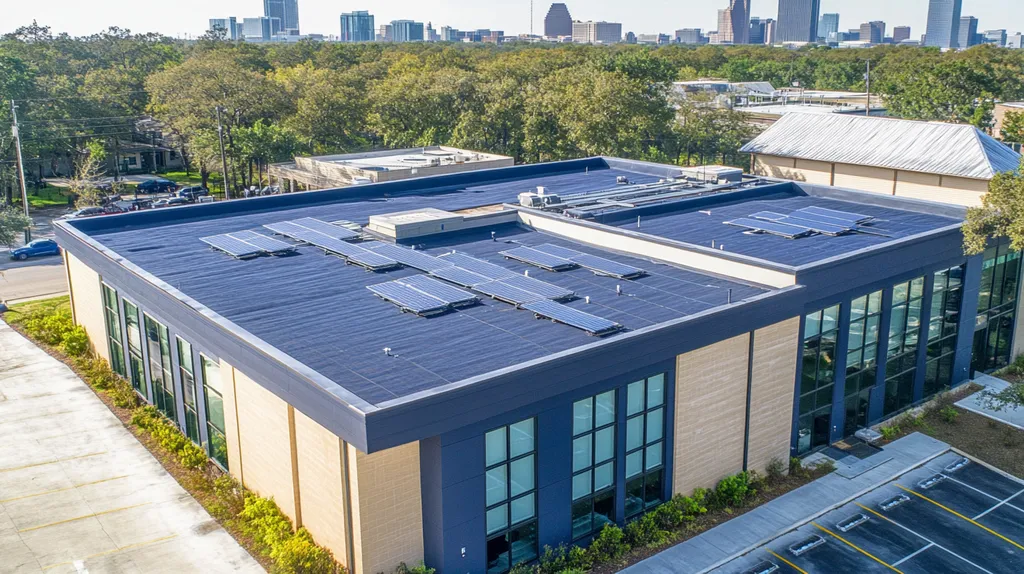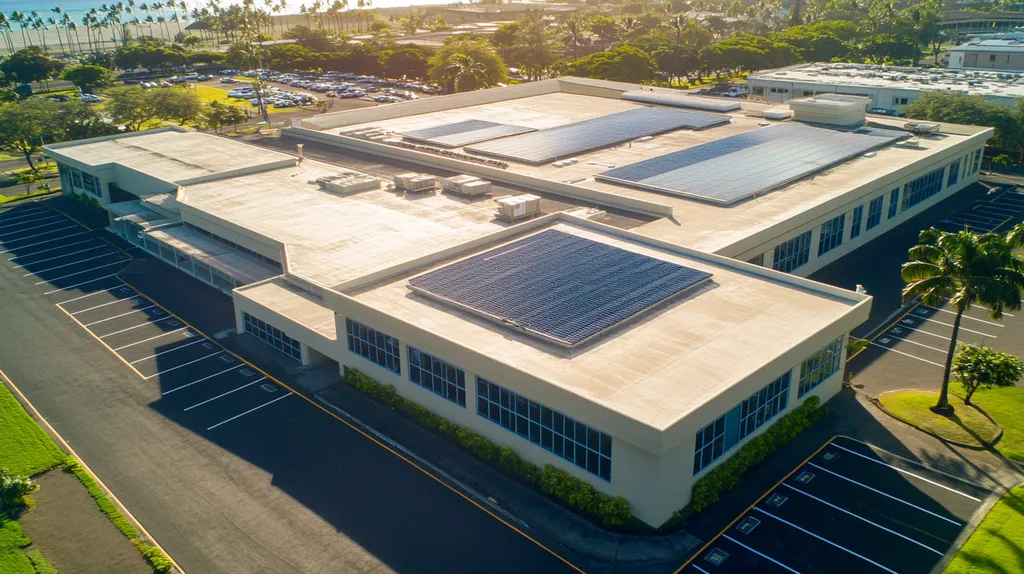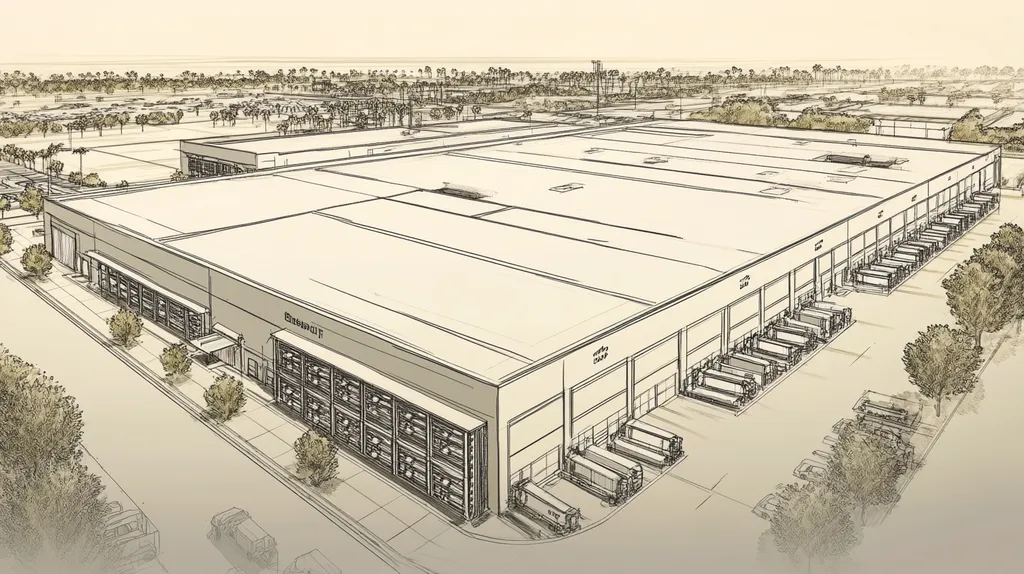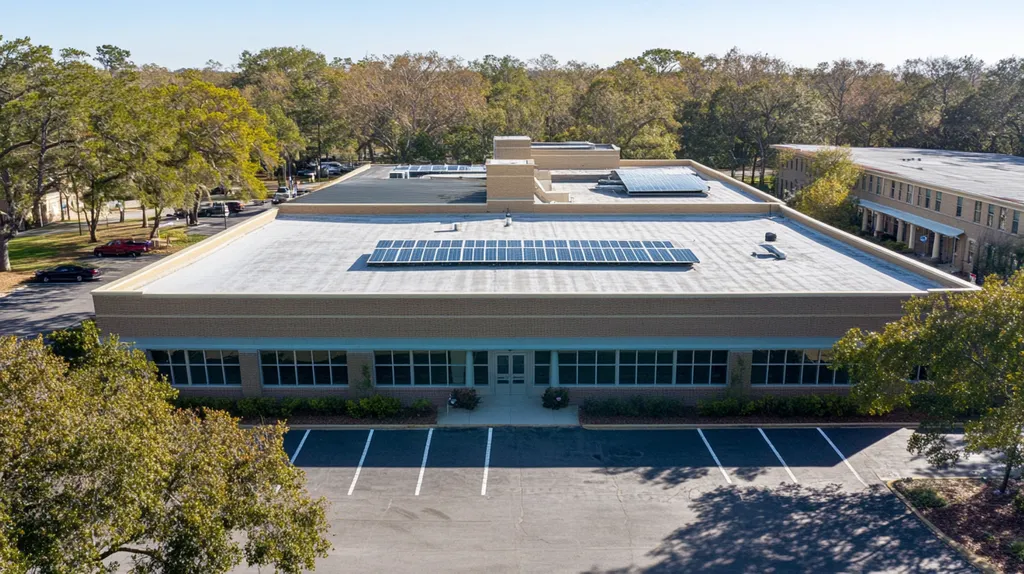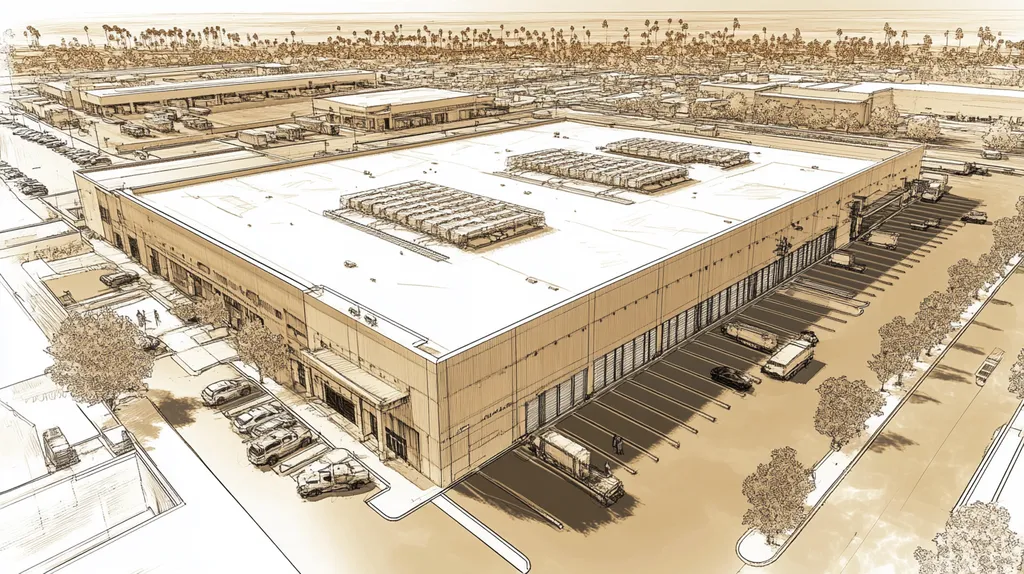As commercial roofing evolves into 2024, lighting design has emerged as a critical battleground for operational efficiency and sustainability. With lighting accounting for nearly 35% of electricity costs in commercial buildings, property owners face mounting pressure to optimize their rooftop lighting systems.
From advanced LED technologies to integrated daylight harvesting, today’s solutions offer unprecedented opportunities for energy savings and enhanced functionality. Yet nearly 60% of commercial properties still rely on outdated lighting infrastructure.
This comprehensive guide examines the key factors driving lighting innovation in commercial roofing, from performance metrics to compliance requirements, providing property managers with actionable strategies for implementation.
SECTION 1: PERFORMANCE FACTORS
As the demands of commercial roofing evolve, effective lighting design has emerged as a cornerstone of operational efficiency and environmental responsibility. With lighting responsible for nearly 18% of total energy consumption in commercial buildings, property owners and facility managers must prioritize energy-efficient solutions, integrate natural light, and ensure durability to optimize roof performance. This section delves into these critical performance factors, exploring their significant impacts on commercial facilities.
Energy Efficiency of Lighting Systems
At the heart of contemporary lighting design for commercial roofs lies energy efficiency. Traditional lighting options, like incandescent bulbs, consume up to four times more energy than LED systems. By switching to LEDs, facilities can actually cut energy consumption by up to 75%.
Energy-efficient lighting not only boasts longer lifespans, reducing the frequency of replacements, but it also decreases labor costs associated with maintenance. While an incandescent bulb might last around 1,000 hours, an LED fixture can shine for up to 25,000 hours.
Investing in these modern lighting technologies not only trims utility expenses but also enhances a property’s sustainability profile. Buildings that embrace energy-efficient lighting solutions may qualify for various efficiency rebates, further maximizing their return on investment.
Key Action Items
Impact of Natural Light Integration
Incorporating natural light into commercial roofing designs offers remarkable advantages for energy savings and occupant well-being. Research indicates that harnessing daylight can decrease reliance on artificial lighting by up to 30%, substantially lowering energy costs.
Popular methods for bringing natural light indoors include skylights and light tubes, which not only illuminate spaces but also elevate a property’s aesthetic appeal. Facilities that adopt skylights often report increased employee productivity and satisfaction, transforming work environments into uplifting spaces.
Additionally, optimizing natural light helps reduce the overall carbon footprint by lessening the dependency on artificial lighting. By integrating daylighting strategies from the outset, property owners create healthier, more productive atmospheres, further enhancing marketability.
As organizations increasingly value wellness and sustainability, properties that emphasize natural light gain a competitive advantage in attracting tenants and clients.
Key Action Items
Lighting System Durability and Maintenance
In the commercial lighting realm, durability and maintenance cannot be overlooked. Weather extremes can take a toll on lighting fixtures, making the selection of weather-resistant solutions crucial for sustaining optimal performance.
Regular maintenance is essential to ensure that lighting systems remain effective over time. An unkept system may lead to inefficiencies and costly replacements, emphasizing the need for proactive care.
Property managers should establish a consistent maintenance schedule that includes inspections and prompt repairs. The advent of wireless technology allows for remote monitoring, facilitating quicker issue resolution and minimizing downtime.
Investing in efficient, durable lighting is not just about meeting operational requirements; it represents a strategic benefit that enhances overall property value in a competitive marketplace.
Key Action Items
SECTION 2: FINANCIAL CONSIDERATIONS
Understanding the financial implications of innovative lighting designs on commercial roofs is crucial. As energy prices continue to rise, businesses must seek effective lighting solutions to manage these expenses. For example, a well-designed LED system can cut energy usage by up to 70%, leading to significant savings over time. This section explores initial installation costs, long-term financial benefits, and available incentives.
Initial Installation Costs and ROI
The initial investment in advanced lighting systems can seem intimidating. Upgrading to energy-efficient technologies often involves higher upfront costs when compared to conventional lighting. Yet, property owners should shift their focus to the potential return on investment (ROI).
While the average cost to install LED fixtures might be higher, they last considerably longer than traditional bulbs, which reduces replacement expenses. Moreover, the savings from decreased energy consumption can quickly recover these installation costs.
To fully understand ROI, businesses should perform cost-benefit analyses for various lighting options. In numerous cases, long-term savings more than justify the initial financial outlay, making the transition to modern systems a sensible choice.
Key Action Items
Long-Term Energy Savings and Costs
Evaluating long-term energy savings is vital when assessing lighting systems. Switching to energy-efficient options can significantly reduce utility costs, providing a rapid payback on the initial investment.
For instance, dimmable LED systems can automatically adjust brightness based on natural light levels, further cutting energy expenses. By incorporating these adaptable technologies, businesses can save thousands annually on energy bills.
Newer technologies also typically require less maintenance and fewer replacements. This further contributes to lower operational costs, complementing energy savings. Regularly analyzing energy consumption can help property managers identify areas needing improvement, enhancing overall energy management.
Key Action Items
Potential for Rebates and Incentives
Recognizing potential rebates and incentives is essential for maximizing financial strategies. Many states and utility companies provide financial incentives for businesses that adopt energy-efficient lighting solutions.
These incentives can significantly offset installation costs—rebates for LED upgrades can often reach hundreds or even thousands of dollars, making the investment even more appealing.
Beyond state and local incentives, some federal programs offer tax credits for energy-efficient improvements. Taking swift action to leverage these opportunities can greatly alleviate the burden of upfront costs, enhancing financial viability.
Key Action Items
SECTION 3: COMPLIANCE REQUIREMENTS
Maintaining compliance with lighting regulations for commercial roofs is not just a matter of legality; it’s fundamental to operational integrity and safety. Ignoring these requirements can lead to serious penalties and jeopardize employee safety. Recent findings emphasize that non-compliance can incur heightened liability and operational expenses, making it essential for property owners and facility managers to remain vigilant in understanding the applicable codes and standards. This section highlights critical compliance issues, including building regulations, safety standards, and sustainability practices.
Building Codes and Regulations
Building codes set the foundation for lighting safety standards on commercial roofs. While these regulations differ regionally, their main goal is to ensure the safety of occupants and protect property. For example, the International Building Code (IBC) specifies required lighting intensity levels in commercial spaces, which inevitably influences energy consumption.
Property owners should investigate local amendments to national codes, ensuring that lighting designs not only satisfy these regulations but also suit specific environmental conditions. Non-compliance can lead to forced structural changes or expensive retrofits, impacting budget and project timelines.
Additionally, compliance can have a positive effect on insurance premiums. Adhering to codes reduces risk, often leading to lower costs for property owners. By prioritizing compliance, property managers can benefit financially while maintaining safety and protecting their assets.
Key Action Items
Safety Standards for Lighting Systems
Safety standards are paramount in preventing accidents related to insufficient lighting in commercial spaces. Regulatory bodies like the Occupational Safety and Health Administration (OSHA) enforce specific illumination levels to protect workers. Failing to comply with these standards can directly impact employee safety and well-being.
For instance, poor outdoor lighting greatly increases the risk of slips, trips, and falls, potentially leading to serious injuries. Investing in compliant, quality lighting not only protects employees but also boosts productivity and overall morale.
Moreover, conducting regular safety audits is essential for identifying deficiencies in lighting systems and ensuring compliance. Prompt action on these issues helps minimize risk and avoid potential legal repercussions. Embracing smart technology for automated lighting can also enhance both safety and regulatory compliance by adapting to user needs.
Key Action Items
Environmental Compliance and Sustainability
Environmental compliance plays an increasingly important role in commercial lighting design. Regulations such as the Energy Policy Act outline essential practices to minimize environmental impact. Ignoring these guidelines can not only lead to substantial fines but can also damage a company’s reputation in today’s eco-conscious landscape.
Utilizing energy-efficient LED lighting is a practical solution for meeting these regulations. Not only do LEDs use far less energy compared to traditional options, but they also have significantly longer lifespans, leading to reduced costs and a smaller carbon footprint. This transition supports sustainability goals while ensuring compliance.
Additionally, many local governments provide incentives for adopting eco-friendly lighting practices, such as tax rebates or grants for upgrading lighting. Property owners should capitalize on these opportunities to ease the burden of compliance and improve profitability.
Key Action Items
SECTION 4: RISK MANAGEMENT
Effective risk management in commercial roofing lighting design is essential for safeguarding both safety and operational efficiency. Neglecting proper lighting can lead to accidents, structural damage, and skyrocketing energy costs. The placement of skylights, for example, requires careful consideration to avoid leaks or compromised integrity. This section examines light-related hazards, the importance of structural integrity, and the challenges posed by weather, providing crucial insights for successful roofing projects.
Mitigating Light-Related Hazards
Safety must remain the top priority for commercial roofs equipped with lighting. Poorly configured lighting can cause glare or shadows, creating hazards that may lead to slips and falls. To address these concerns, property owners should select features that promote even illumination, such as diffused LED lighting.
Ongoing maintenance checks are equally vital to ensure lights are functioning properly and remain free from obstructions. Adopting a proactive approach can help identify potential issues early, reducing the likelihood of accidents.
Incorporating motion sensors offers an additional layer of safety, activating lights only when necessary, which not only conserves energy but also enhances overall visibility. Together, these measures support a safer environment on commercial rooftops.
Key Action Items
Ensuring Structural Integrity with Skylights
While skylights can significantly enhance natural lighting and improve energy efficiency, they also introduce potential structural vulnerabilities if improperly installed. The added weight from snow or water accumulation can lead to roof failure if not properly considered during planning.
To ensure the roof remains structurally sound, roofing professionals must select materials that match the roof’s design and load capacity. Conducting comprehensive assessments before installation is critical to mitigate risks associated with skylight placements.
Investing in double-glazed or impact-resistant skylights not only enhances durability but also reduces ongoing maintenance requirements. This foresight protects the roof while improving interior lighting quality and comfort.
Key Action Items
Managing Weather-Related Risks
Weather-related challenges are particularly significant when it comes to lighting systems on commercial roofs. Heavy rain, snowfall, or high winds can adversely affect the performance and safety of lighting installations. It’s crucial to utilize weather-resistant fixtures and materials to protect against damage and ensure functionality.
Regular inspections before and after severe weather can help identify vulnerabilities or damage to lighting systems. Such diligence allows for timely repairs, which can minimize risks of system failure or accidents.
Implementing a weather-responsive lighting system can enhance efficiency, automatically adjusting based on external lighting conditions. This not only improves safety but also contributes to energy conservation, yielding long-term savings for property owners.
Key Action Items
SECTION 5: OPERATIONAL PROCEDURES
Implementing robust lighting solutions on commercial roofs hinges on precise operational procedures. A thorough installation and commissioning process establishes a strong foundation for the system’s durability, while scheduled maintenance keeps lights functioning at peak efficiency. Overlooking these critical procedures can lead to higher costs and compromised safety. By prioritizing these aspects, property owners can safeguard their investments and ensure optimal performance.
Installation and Commissioning Processes
The installation and commissioning of roof lighting systems demand strict adherence to established protocols to guarantee maximum functionality. Following manufacturer guidelines is vital in avoiding potential hazards and ensuring compliance with safety standards. For instance, carefully choosing installation locations can greatly reduce shading issues and enhance brightness.
During the commissioning process, it is essential to verify the performance of each fixture thoroughly. This includes testing electrical connections and confirming that all systems operate together seamlessly. Conducting a comprehensive inspection helps avert future malfunctions that could disrupt daily operations.
Moreover, maintaining comprehensive documentation of the installation process provides a reference for future maintenance and repairs. This organized record of equipment specifications equips facility managers with essential information when needed, thus minimizing downtime and elevating operational efficiency.
Key Action Items
Routine Maintenance and Inspection
Establishing consistent maintenance and inspection schedules is crucial for the longevity of commercial roof lighting systems. Performing these inspections at least twice a year enables property managers to identify potential issues before they escalate. Promptly addressing repairs not only extends the life of the lighting but also enhances energy efficiency.
During maintenance visits, cleaning fixtures is essential. Accumulations of dust and debris can significantly reduce light output. Ensuring all lenses remain clear maximizes light penetration, improving visibility and ensuring safety during rooftop activities.
Moreover, inspecting electrical connections and components is critical. Loose wiring or signs of corrosion can lead to failures or hazardous conditions. Regular checks for such issues help maintain efficiency and readiness for operation.
Key Action Items
Troubleshooting Common Lighting Issues
Identifying and addressing common lighting issues promptly can save both time and resources for commercial roofs. Flickering lights, unexpected outages, and uneven illumination are frequent concerns that can hinder safety and operational effectiveness.
For flickering lights, inspecting the electrical system is crucial. Loose connections or voltage fluctuations typically cause these issues. Testing circuits and securing connections can often resolve the problem without extensive repairs.
Unexpected outages may suggest equipment replacement is necessary or indicate a circuit breaker issue. Periodic assessments of the status of fixtures and breakers can help identify these problems early, facilitating swift resolutions.
Key Action Items
SECTION 5: OPERATIONAL PROCEDURES
Implementing effective lighting solutions on commercial roofs hinges on meticulous operational procedures. Proper installation and commissioning set the stage for long-term durability, while routine maintenance ensures that lighting systems operate efficiently and safely. Ignoring these critical components can lead to increased operational costs and compromised safety. By addressing these key procedures, property owners can safeguard their investments and significantly enhance lighting performance.
Installation and Commissioning Processes
The successful installation and commissioning of roof lighting systems require strict adherence to established protocols to ensure optimal performance. Following manufacturer guidelines is crucial for avoiding potential hazards and complying with safety standards. Thoughtfully selecting installation locations can greatly minimize shading issues and enhance overall brightness.
During the commissioning phase, it’s vital to verify that every fixture operates correctly. This involves checking electrical connections and ensuring that all lighting systems are integrated seamlessly. A comprehensive inspection at this stage can help prevent future malfunctions and maximize operational efficiency.
Documenting the installation process provides a reliable reference for future maintenance and repairs. An organized record of equipment specifications and installation details ensures facility managers have essential information readily available, which reduces downtime and elevates operational efficiency.
Finally, training staff on effective lighting operations is essential. Empowering employees with this knowledge enables them to tackle minor issues before they develop into major problems, fostering a proactive culture within the organization.
Key Action Items
Routine Maintenance and Inspection
Establishing a consistent routine for maintenance and inspection is essential for the longevity of commercial roof lighting systems. Scheduling inspections at least twice a year allows property managers to identify issues before they become critical. Addressing repairs promptly can extend the lifespan of the lighting and enhance energy efficiency.
During maintenance visits, regularly cleaning fixtures is crucial. Dust and debris accumulation can significantly diminish light output. Ensuring that all lenses are clear maximizes light penetration, improving visibility and safety during rooftop activities.
Additionally, checking electrical connections and components is vital. Loose wiring or corrosion can lead to failures and hazardous conditions. Regular inspections for these issues help maintain operational readiness and reliability.
Further documentation of maintenance activities serves as a reference for compliance and future work. Keeping organized logs not only signals the importance of maintaining lighting systems but can also support warranty claims or insurance inquiries.
Key Action Items
Troubleshooting Common Lighting Issues
Promptly identifying and addressing common lighting issues can save both time and resources for commercial roofs. Frequent concerns include flickering lights, unexpected outages, and uneven illumination. Quickly resolving these issues helps maintain safety standards and operational efficiency.
For flickering lights, a thorough evaluation of the electrical system is essential. Loose connections or voltage fluctuations are often the culprits. Testing the circuit and securing connections can usually rectify the problem without extensive repairs.
Unexpected outages may indicate the need for equipment replacement or an issue with circuit breakers. Regular checks on the status of light fixtures and breakers can help catch these issues early, ensuring swift resolutions.
Additionally, uneven illumination may signal obstructions or fixture placement problems. Conducting visual inspections to assess light distribution allows for adjustments, ensuring every area receives adequate lighting for safety and functionality.
Key Action Items
Looking Ahead
As commercial roofing technology races forward, lighting design stands at a critical crossroads where efficiency meets innovation. Industry data shows that properties failing to upgrade lighting systems now face up to 40% higher operational costs by 2025.
The evolution from simple illumination to intelligent, integrated lighting networks marks a fundamental shift in commercial roofing standards. Yet nearly 65% of properties still rely on outdated systems that compromise both safety and efficiency.
The convergence of LED technology, natural light integration, and smart controls has created unprecedented opportunities for property enhancement. Those who embrace these advances position themselves for substantial cost savings while meeting increasingly stringent environmental regulations.
The message is clear: the future of commercial roofing belongs to those who recognize that innovative lighting design is no longer optional—it’s essential for survival in today’s competitive market.
FREQUENTLY ASKED QUESTIONS
Q. What are the energy efficiency benefits of commercial roof lighting?
A. Upgrading to energy-efficient lighting can cut energy consumption significantly. For example, LED systems can reduce energy use by up to 75%. This shift not only lowers utility bills but also contributes to a property’s sustainability profile.
Q. How can commercial roof lighting lower operational costs?
A. The transition to energy-efficient lighting often results in significant long-term savings. Dimmable LED systems can adjust brightness according to natural light, which helps reduce overall energy expenses and maintenance costs.
Q. What compliance regulations should I consider for industrial roof lighting?
A. Be aware of local building codes and workplace safety standards. These regulations often specify necessary illumination levels and safety protocols to protect both property and employee well-being.
Q. How can I ensure my commercial roof lighting has adequate durability?
A. Selecting weather-resistant lighting fixtures and establishing a regular maintenance schedule enhances durability. Periodic inspections help identify potential issues and ensure long-term performance under varying conditions.
Q. What are the risks of poor lighting design on commercial roofs?
A. Inadequate lighting can lead to accidents, including slips and falls, as well as hindering operational efficiency. A well-designed lighting system minimizes these risks and ensures a safe working environment.
Q. What common issues should I troubleshoot with roof lighting?
A. Common issues include flickering lights, unexpected outages, and uneven illumination. Regular inspections and proactive troubleshooting can mitigate these problems before they impact safety and productivity.
Q. How can incorporating natural light benefit commercial roofs?
A. Natural light integration can reduce reliance on artificial lighting, improving energy efficiency and creating a more pleasant working environment. Skylights and light tubes can enhance aesthetics and promote employee well-being.

